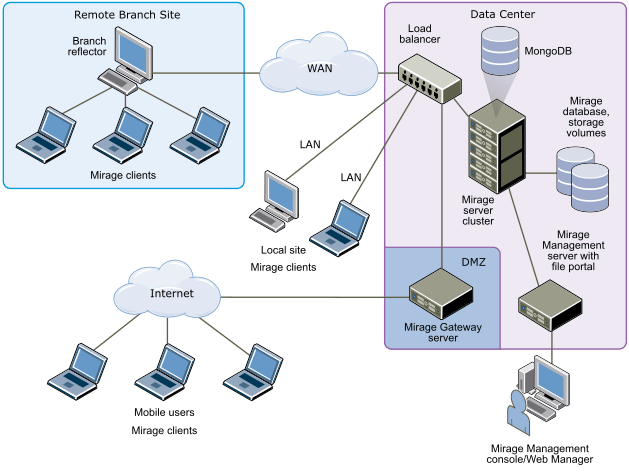What Is VMware Mirage?
VMware Mirage offers a unique solution for managing/upgrading physical or virtual desktops and laptops, and for BYO users, combining centralized management for IT and local execution for end users.
Once you have Mirage client is installed on a PC or POS device, it scans the entire device and categorizes all of its contents into a number of logical layers. It just categorizes the data, so that your IT staff can perform more granular management of the endpoint. Mirage Client then sends a complete copy of that endpoint image to the Mirage Server, which resides in the data center and keeps it synchronized. If an end user goes offline, Mirage performs a synchronization the next time that user comes back online. That synchronization includes the updates IT has made to the IT-managed layers, as well as changes that the end user has made to the system. End users can leverage local compute power, such as CPU or graphics, whether they are online or offline.
VMware Mirage Architecture is composed of several components i.e VMware Mirage Server, VMware Mirage Management Server, VMware Mirage Web Console, VMware Mirage Client, etc. Each of those components is to be installed on a particular place in your datacenter or on the client computers etc.

Let’s discuss which all components are used in the VMware Mirage architecture.
VMware Mirage Components
- VMware Mirage Management Server → It is the component located in the data center that controls and manages the Mirage server cluster. Installing multiple Mirage Management servers increases Mirage availability in the event that a Mirage Management server fails. VMware recommends to set up multiple Management Servers to prevent data loss in case the Management Server fails. In a Lab / POC, we can have only 4 components i.e Mirage Server, Mirage Management Server, Mirage client & Mirage Console. VMware Mirage uses the MongoDB file database to store system data and small files, reducing IOPS and upload time. A MongoDB instance is installed with each Mirage Management server that you install.
- VMware Mirage Server → Located in your datacenter, it keeps Mirage Client synced with Mirage server, manage storage, delivery of OS base layer, application layer, CVD (centralized virtual disk) to clients and consolidate monitoring of management communication. VMware recommends to set up multiple Management Servers to prevent data loss in case the Mirage server fails. It is good practice to keep the server on a dedicated machine or a virtual machine. However, a server can run on the same machine as the Mirage Management server.
- VMware Mirage Management Console → The administrator can use the Mirage Management console to configure and manage Mirage clients, base layers, app layers, reference machines and to update and restore CVDs.
- VMware Mirage Client → Mirage Client is to be deployed on the client’s computers. It keeps pushing the data from the client to the Mirage Server in your datacenter. It can be from the LAN or over the WAN. VMware Mirage Branch Reflectors can be deployed if deployed over the WAN. Mirage client does not create or emulate a virtual machine. The Mirage Client software can installed in an OS running on physical or a virtual machine running on Type 1 or Type 2 hypervisor.
Installation Prerequisites
Mirage Client: Supported Client Operating Systems
- Windows XP Professional with SP3, 32-bit
- Windows Vista Business or Enterprise, 32-bit, and 64-bit
- Windows 7 Professional or Enterprise, 32-bit, and 64-bit
- Windows 8.0 and 8.1 Professional or Enterprise, 32-bit and 64-bit
- Windows 10 Professional or Enterprise, 32-bit, and 64-bit
- Windows Embedded Point of Service (WEPOS), 32-bit
- Windows Embedded POSReady 2009, 32-bit
- Windows Embedded POSReady 7, 32-bit and 64-bit
Microsoft .NET Framework version 3.5 SP1 or later
Mirage Server and Mirage Management Server
Windows 2008 R2 with SP1 and above with Domain membership. Microsoft .NET Framework version 3.5 SP1 or later
Minimum RAM: 8 GB n Minimum CPU: 4 vCPU n Minimum System Drive capacity: 146 GB, including 100 GB for the Mirage network cache, 2 x Gigabit Ethernet Port Note It is good practice to separate client network and storage network access to dedicated ports.
Mirage Web Management:
Microsoft IIS 7.0 or later. Microsoft .NET Framework 4.5.1 or later.
Database Server
- Windows Installer 4.5 (MS KB942288) or later
- Microsoft SQL Server 2012 64-bit SP1 Express
- Standard, and Enterprise editions
- Microsoft SQL Server 2008 64-bit R2 Expres, Standard, and Enterprise editions
- Microsoft SQL Server 2014 Express, Standard, and Enterprise editions
- Microsoft SQL Server 2016 Express, Standard and Enterprise editions
MS SQL Server must be set up with Windows Authentication. The Windows account used for installing Mirage must have dbcreator privileges, and the user account running the Mirage server services must be configured with access privileges to the Mirage database.
You can refer to Installing Guide for more details on planning the VMware Mirage Deployment for a production deployment.
Summary
This completes the introduction to VMware Mirage Server and its architectural components. In next blog of this series, we will be installing VMware Mirage server. I hope this will be informative for you. Thanks for Reading !!. Be social and share on social media if you find worth sharing it.